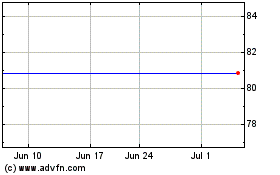St. Jude Medical Announces Multiple Enhancements to Industry-Leading PressureWire FFR Measurement System
March 15 2010 - 7:58AM
Business Wire
St. Jude Medical, Inc. (NYSE: STJ), a global medical device
company, announced several updates to its PressureWire™ platform,
including a new marketing agreement with Siemens Medical Solutions
USA, for the wireless PressureWire™ Aeris and the availability of
the next-generation of PressureWire™ Certus technology, at the
American College of Cardiology (ACC) and the Society of
Interventional Radiology (SIR) annual meetings. The enhanced
capabilities make the company’s leading Fractional Flow Reserve
(FFR) measurement technology, which aids in the diagnosis and
treatment of coronary artery blockages, more versatile and
accessible for physicians around the world.
The PressureWire Aeris and Certus provide FFR measurements,
which indicate the severity of blood flow blockages in the coronary
arteries. This physiological measurement helps physicians to better
identify which specific lesion or lesions are responsible for a
patient’s ischemia, a deficiency of blood supply to the heart
caused by blood restriction.
“The PressureWire segment is one of the biggest areas of growth
for St. Jude Medical’s interventional business because of its
clinical benefits and ability to reduce the cost of PCI
procedures,” said Frank Callaghan, president of St. Jude Medical’s
Cardiovascular Division. “We continue to invest in PressureWire
technology to improve its ease-of-use and to help establish FFR
measurement as a standard of care across a broader range of
patients.”
PressureWire Aeris
Agreements:
The PressureWire Aeris system offers a secure, wireless
interface between PressureWire and a cath lab’s hemodynamic
recording system to immediately display, measure and save FFR data.
With FFR results integrated into a patient’s existing study record,
the severity of coronary lesions is documented together with other
procedural data and angiographic imagery. The wireless technology
of the PressureWire Aeris also eliminates cables crossing the
sterile field, reducing variables and making the entire procedure
faster and easier.
St. Jude Medical’s new agreement with Siemens will enable
integrated wireless FFR measurement with PressureWire Aeris as an
upgrade to hospitals using the Siemens AXIOM Sensis XP. The AXIOM
Sensis XP is one of the most widely used hemodynamic recording
systems in cath labs and offers advanced measurement programs which
aid physicians in interventional procedures.
Because of this new agreement with Siemens, and existing
compatibility with other recording systems including the GE
Mac-Lab® Hemodynamic Recording System, Mennen Horizon XVu and the
McKesson Horizon Cardiology Hemo™ solution, the PressureWire Aeris
technology can be used in the majority of cardiac cath labs for
wireless integrated FFR measurement utilizing existing
hardware.
Next-Generation PressureWire
Certus:
The new PressureWire Certus includes modifications to design and
functionality which will provide physicians with more controlled
handling and versatility. It is the only guidewire on the market to
offer in one wire the combined measurement of pressure and
temperature which enables calculations of FFR, Coronary Flow
Reserve (CFR) and an Index of Microcirculatory Resistance
(IMR).
The PressureWire Certus was the only FFR measurement system used
in the landmark FAME (Fractional Flow Reserve (FFR) vs.
Angiography in Multivessel Evaluation) trial, which found both
superior clinical outcomes and reduced healthcare costs in patients
whose treatment was based on FFR.
FAME Trial:
Recently presented two-year follow-up data from the landmark
FAME trial demonstrated that the combined risk of death or
myocardial infarction (heart attack) was 34% lower for patients
whose treatment was guided by PressureWire technology prior to
coronary stenting. Additionally, FFR measurement did not increase
the procedural time.
FFR-guided treatment using the PressureWire system was also
found to save healthcare costs, with a difference of about $2,000,
or 14%, in reduced costs between the two patient groups after one
year. These lower healthcare costs were a result of reduced
procedural costs, reduced follow-up costs for major adverse cardiac
events and shorter hospital stays.
About Fractional Flow Reserve (FFR)
Fractional Flow Reserve (FFR) is an index determining the
functional severity of narrowings in the coronary arteries, and it
is measured by PressureWire Aeris and PressureWire Certus. FFR
specifically identifies which coronary narrowings are responsible
for obstructing the flow of blood to a patient’s heart muscle
(called ischemia), and guides the interventional cardiologist in
assessing which lesions warrant coronary interventions which
results in improved treatment outcomes.
About St. Jude Medical
St. Jude Medical develops medical technology and services that
focus on putting more control into the hands of those who treat
cardiac, neurological and chronic pain patients worldwide. The
company is dedicated to advancing the practice of medicine by
reducing risk wherever possible and contributing to successful
outcomes for every patient. St. Jude Medical is headquartered in
St. Paul, Minn. and has four major focus areas that include:
cardiac rhythm management, atrial fibrillation, cardiovascular and
neuromodulation. For more information, please visit sjm.com.
Forward-Looking Statements
This news release contains forward-looking statements within the
meaning of the Private Securities Litigation Reform Act of 1995
that involve risks and uncertainties. Such forward-looking
statements include the expectations, plans and prospects for the
Company, including potential clinical successes, anticipated
regulatory approvals and future product launches, and projected
revenues, margins, earnings and market shares. The statements made
by the Company are based upon management’s current expectations and
are subject to certain risks and uncertainties that could cause
actual results to differ materially from those described in the
forward-looking statements. These risks and uncertainties include
market conditions and other factors beyond the Company’s control
and the risk factors and other cautionary statements described in
the Company’s filings with the SEC, including those described in
the Risk Factors and Cautionary Statements sections of the
Company’s Annual Report on Form 10-K for the fiscal year ended
January 2, 2010. The Company does not intend to update these
statements and undertakes no duty to any person to provide any such
update under any circumstance.
SJM (NYSE:STJ)
Historical Stock Chart
From Jun 2024 to Jul 2024

SJM (NYSE:STJ)
Historical Stock Chart
From Jul 2023 to Jul 2024
